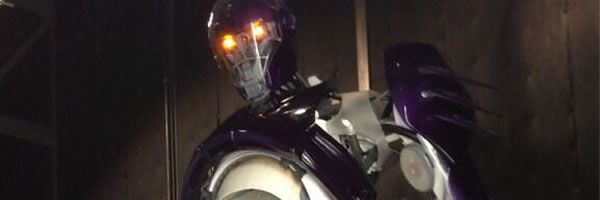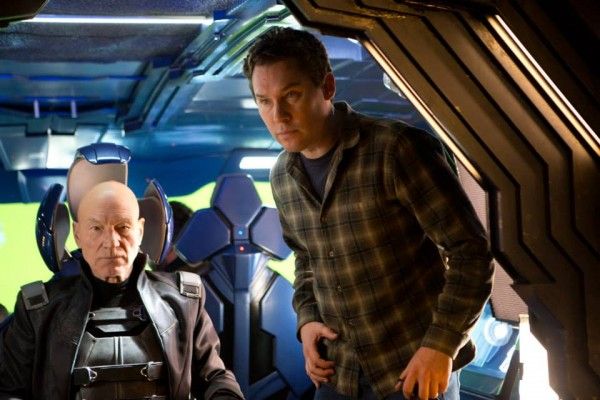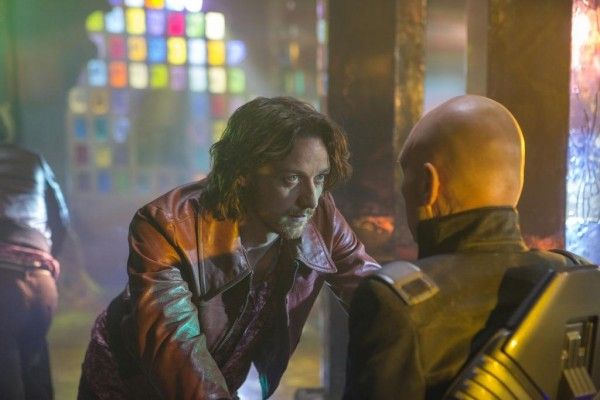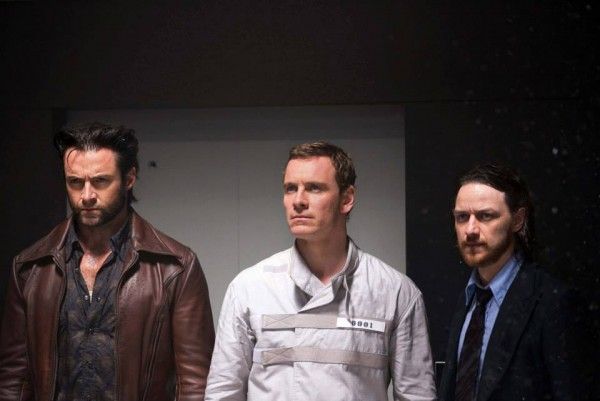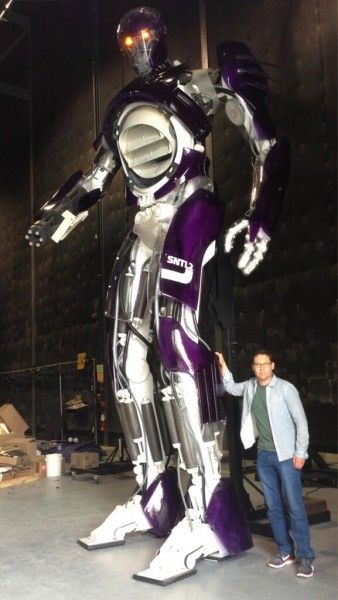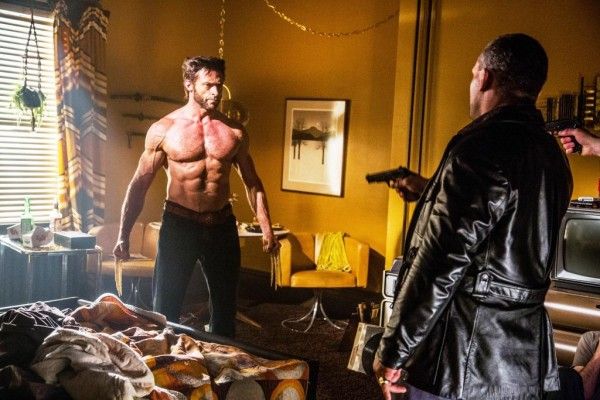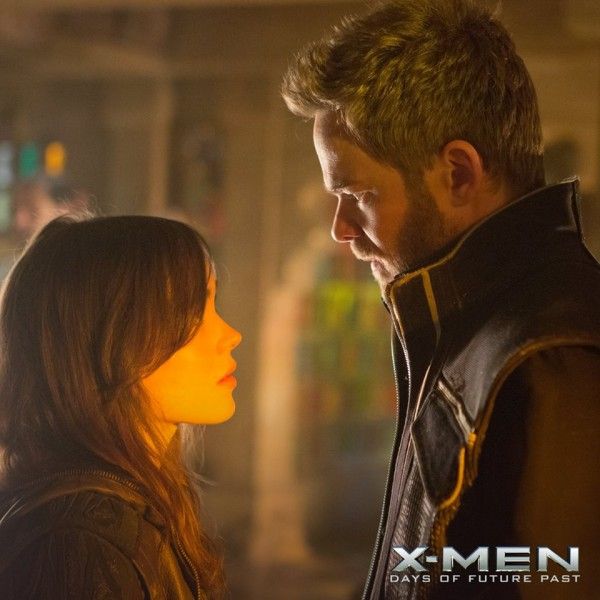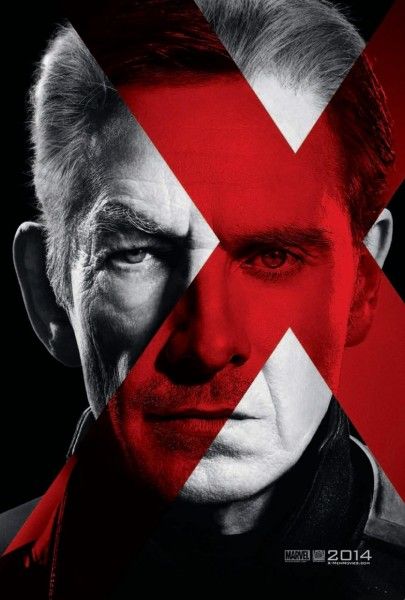Last year, when Bryan Singer’s X-Men: Days of Future Past was filming in Montreal, I got to visit the set with a few other reporters. For those not familiar with the story, the movie finds Wolverine (Hugh Jackman) having his consciousness sent back to 1973 in order to help Professor X (James McAvoy), Magneto (Michael Fassbender), and the rest of the X-Men: First Class crew stop the rise of the Sentinels, giant robots programmed to exterminate mutants. The film also takes place in the future, so we’re going to see the original X-Men cast and what will happen if Wolverine fails. Trust me, Days of Future Past is a very cool storyline, and a perfect way to have the old and new cast in one film.
During a group interview with Production Designer John Myhre, he talked about returning to the franchise, if they used any of the First Class sets, if he felt limited by his previous designs, designing the Sentinels, how many of the sets are digital, the look of the future sequences, if he incorporated things from the comic books, hiding a bunch of Xs throughout the film, and a lot more. Hit the jump for what he had to say.
Question: When you guys did the first movie, you were in essence at the beginning of the superhero movement. Back then you guys were given $5 to make an X-Men movie. Now you're making a film with Academy Award-winners, the whole planet is looking forward to this, and the superhero genre is the biggest ever. What's it like now designing and coming back full circle?
JOHN MYHRE: It's the first time I've ever come back on to a project. I did the first one 12 years ago and I haven't done any of the ones in between. But Bryan called me and said, "Hey, I'm doing this next one I want to bring the creative team back." So he brought back Tom Sigel, the DP, Louise Mingenbach, the costume designer, and myself. So I thought it would be kind of fun to re-imagine it. We went in to the first one and it was pretty much a clean slate. We had the comic books to look at but we really felt we wanted to be faithful to what the fans wanted but we had a lot of input ourselves. We felt we could design an X-Jet that was our X-Jet. A Cerebro that was our Cerebro. An underground world that's since become iconic.
On this one, we were able to rebuild and kept a couple of the same things. Bryan very much said "I don't want to do anything exactly the same. It's a new movie. It's a new project. Let's have fun with that." So the only sets we rebuilt like the ones we did 20 years ago were the blue underground hallways and Cerebro. But when you see the film it'll have a whole different look. The government has completely taken over. The blue hallways are absolutely destroyed. What was really fun was I literally pulled the plans out from 12 years ago and blew the dust off. But when you see it in the movie it'll be completely different. The panels are all torn apart. The place has been ransacked. I think it was the first day of shooting. It was really fun to start the new adventure with something we were familiar with, but was completely different.
Did you inherit any of the First Class sets or did you decide to do your own take on it?
MYHRE: There wasn't anything we recreated from First Class. With the exception of the blue hallways and Cerebro every film has reinvented itself. Even the X-Jet changes every time. Something I took from First Class—I loved how it really embraced the time period of the 60s. And part of our film takes place in the 70s so I tried to do the same thing.
Was there any sense of feeling limited by your past designs?
MYHRE: No, not at all. Again, very little of it did we recreate. And when you see the movie it's like two movies. It's massive. It's the first really epic X-Men. We did shoot a lot of the future sequences with the original cast first. And the scale of what we built and what we shot really was an entire movie. It was funny, halfway through realizing some of those performers—Patrick Stewart, Ian McKellen—were going away and then the younger versions of themselves were coming in. And we had a couple moments where you could see the crossover and it was very exciting.
The success of the movies is from Bryan Singer and how he cast the first one and how he treated the characters so seriously. He really wanted to understand a logic to everything and see that these were real people. And I feel that was the success of the first one. The casting through all of them has remained unbelievable. I think someone was saying, you've got this generation of established actors that are just the best in the world. If you went to people and said, "Who are the best actors in Hollywood?" We have them! Everyday I walk on set and go "That's Michael Fassbender."
You're really lucky to work on movies and it's hard work and stressful with long hours but you get these special moments. I got to stand on set when Michael Fassbender gave what I can only call a soliloquy as Erik to the world about what was happening with mutants. I'm getting shivers now. It was like watching somebody in England doing a Shakespearean monologue. It was just so commanding. He stood there in front of 200 or 300 people and you could hear a pin drop. Amazing.
When did you first find out you'd be coming back? Can you talk about the timeframe?
MYHRE: Two months too late. I got a call from Bryan on a Monday. I met up with him on a Tuesday. Had a creative meeting with Bryan, the producers and the writer on Wednesday, and I was in Montreal on Thursday. It was exciting that we had this amazing cast but when you're dealing with almost any one of the actors we have in our movie you schedule around them. But for us to deal with all of these actors that have such tight schedules we had a start date that was really two months from being just impossible. We needed two months to build these sets and figure this out. But we didn't have them. So we started in December knowing that we needed to be filming in the middle of April.
We had some very, very big sets that you would normally say, "This is a 16 week build with 6 to 8 weeks of drawing.". And that's not even really getting in to the design phase, getting everyone to understand what it is and how it works with the story. And then the whole budgeting process. We had to take six months and squeeze it down in to 3-4 months.
From what we've heard there are some international locations. Can you tell us about designing some of those things as far as what Moscow looks like, etc.
MYHRE: I hope we have a really exciting new look in Moscow. When I opened up the pages of the script and it was talking about Moscow in the future partially destroyed I kind of went, "Wow, I've seen that in about 3 or 4 major movies in the past three years." But we came up with an idea visually that is really interesting and a new take on it. But I'm not allowed to talk about it. Paris was Paris in the 70s and that's really sort of what we embraced. There was a famous event at a peace conference in Paris that we tied to. So we didn’t literally recreate the exact hotels and rooms but really the feeling and ambience of the period. We spent a lot of time in Washington DC and spend a lot of time obviously in upstate New York with the X-Mansion. We're in the mountains China. We really are all over the place.
Something we don't know that much about are the Sentinels and how they interact with the characters and the world. I don't know what you can talk about there. But is there a sense of designing for a bigger scale?
MYHRE: What I can tell you as a designer is that again I really wanted to embrace the 70's. I love that 70's style of design of molded plastics and white plastics and smoked plastics and looked at a lot of car design and futuristic concepts from the 70's on a high end but also stereos. So I was the idiot going in there saying this is what the Sentinels look like. Like I was crazy. It was the very first thing we started designing for the 70's sentinels and the future sentinels. Brian was immediately very excited for our concept of the future. The 70's was a bit more complicated that you really want to be faithful for the fans in the books so there a lot of elements that needed to be a humanoid shape to have a head arms and needed to be purple. There were a lot of things we had to do to give them a different look. But it really was the idea of being inspired by 70's product design that helps out
What was the one set you were most excited to do but at the same time more nervous to do?
MYHRE: We have this ancient monastery up in the hills in China. It's built so high up there's no roads to it. And it was inspired by some real Chinese temples that are on the side of cliffs. As somebody who builds things I have no idea how they built them. We wanted it to be a very special place. There've been a lot of monasteries recently in movies. And I had heard years ago somebody going to a monastery in India that was carved out of a single stone. So I started doing research and there were truly monasteries if you can imagine they would carve something like this out of one rock. So that when they're carving in to it they have to know where that one column is going to be and where that column was going to be. Leave space out for these molding details. It would be such an unbelievably complicated fantastic thing. But you have to really be devoted to a cause to do it.
So in our mind it was a sacred mountain that had a sacred area deep within that had some natural caves and passageways but the rest of it was carved. We wanted it to look like real architecture. And we had a feeling that it's all styles of Asian architecture. Not just Chinese but Indonesian, Indian—a real mixture of things. It was a real exciting set to do. The only nervous thing was physically the amount of time we had. It was one of those sets that requires an enormous amount of time because you're sculpting, you're casting, you're molding. The scale was such that we had to have a metal structure just to take it away. Sadly, we were painting up until the actors were there. I'm sure Hugh Jackman has some paint on the bottom of his shoes.
Even though I knew we had a very limited amount of time. I didn't want that to hinder Bryan. So we just drew what we wanted it to be. So what we drew was absolutely massive and the reality came in that parts of it could be built. What do we utilize? What becomes the most important sections of it. So we basically did a slice of a pie the whole way through. It was 120 feet by 300 feet, so it's a big set. But there will still be set extensions to the left and right and other areas that we'll add in. We had a big wall inspired by the Great Wall of China. It was all built to protect a sacred area at the center of the monastery. We had pagodas. We had a beautiful entryway. Lots of statuary. Very ornate.
Especially with a time crunch like this, did you rely on any digital sets?
MYHRE: Absolutely. So much of this movie is being extended through digital sets. This is a perfect example. We only had the time and space to build a section of it. So definitely areas where the X-Jet was actually landing. Other areas where big action sequences are taking place were created in the digital world. We built a lot of pieces of the exterior jet, but we never built the entire jet. We even did it on the first one. I don't know if on any of the X-Men’s if they ever built a full jet. The cost of building something. All the compound curves. They generally build around the front cockpit so you can look in the front window. It's very much the same as the first one.
I know you can't talk much about the look of the future sequences. But can you talk about your influences when designing it.
MYHRE: The fun thing about this is the other X-Men movies are always great battles, great action sequences but they're always fighting something specific. And here they're at war. I don't think we've ever seen them at war before. We've seen them go "There's the bad guy!" and beat them up in two weeks and then it's done. This one really should've been called The Last Stand but one had already done that. There's only a very finite number of mutants left in the world. And we come in to the movie with the original cast, war torn. The ship is scratched, broken and leaking oil every where. They're wearing outfits that are much more armored and the whole thing is they're in battle. And when we come in to the movie we realize they only have days left and then they're gone. They have to come up with something. So we wanted that to be the look of the world. The world is on its last legs.
How much are you looking at the comic books and trying to incorporate things or give a nod to the fans?
MYHRE: All the time. Whenever a character came in that was new to me we would go through the history. Particularly the older characters or even the Sentinels. The first thing I did was say, "What do the Sentinels look like?" And it's amazing how often they've changed since the 60s and stayed quite often the same. But as the comics grew and became more sophisticated, there's a whole arc and most of the characters are that way. When a new character comes up—and even during shooting a new character came up. We sort of went through the history, laid it all out and talked to Bryan to see what elements we wanted to incorporate. It's really important to Bryan that fans aren't cheated. They feel like they're getting the real thing.
So another character was written in?
MYHRE: I don't know if it was "in" or maybe early on but it seemed that as the fight in the monastery was developing there were some other ideas. Maybe not while we were shooting but as we got closer to.
Was there anything you were really frustrated by?
MYHRE: Even though we didn't have a lot of time you have to really fight for what you want. I fought for this X in the staircase. That was something I refused to let go.
Will we even notice that in the film?
MYHRE: I don't think Bryan ever wanted to just completely focus on the Xs, but there are Xs everywhere. It's funny, one of the producers said, "Give me a list of all the Xs." And I said "I didn't make a list." It's just a fun thing to do. There doesn't have to be an X on every single set but on the first one we brought in a lot but it's also interesting how many Xs there are in the real world. One of my favorite ones we did on this was in front of their house I wanted to do a circular drive in front of the mansion. And we were putting a hedge in with a fountain and I said. Why don't we make it a list. You don't ever plan anything. So I took the big circle and just made a big X in the center.
As a designer, do you have anything specific that inspires you?
MYHRE: This thing in Moscow was something I always wanted to do. There's an architect by the name of Marcus Lapidus who I've always loved and wanted to work in. I don't literally keep a book but there are favorite things or thoughts. And sometimes you get inspired by reading the script. When I read the script I see it in front of my eyes and sometimes a memory of something like that will work its way in. We do have a lot of leeway, but Bryan wants to make sure that nothing gets too out of reality. So if you have an idea that's sort of wild—which we do—you just have to build it in a way that's real. That it's not a magic material. That it's concrete and paint. That's why he's so good with these movies.
Is there any difference in designing for 3D?
MYHRE: Yeah, you've got things like these columns to shoot through. You see those moldings down there that are 9 inches deep. Anytime you can give foreground. Anytime you can give something extra dimensions. Absolutely.
For more X-Men: Days of Future Past set visit coverage, here’s a list of links:
- Producer Lauren Shuler Donner Talks the Darker Tone, Casting, the X-MEN Franchise, DEADPOOL, Sequels, and More on Set of X-MEN: DAYS OF FUTURE PAST
- 90 Things to Know about Bryan Singer’s X-MEN: DAYS OF FUTURE PAST from Our Set Visit
- Hugh Jackman Talks Reuniting with Bryan Singer, Battling Sentinels, How Long He’ll Play Wolverine, and More on the Set of X-MEN: DAYS OF FUTURE PAST
- James McAvoy Talks Hanging Out with the Cast, His Scene with Patrick Stewart, Professor X’s Hair, and More on the Set of X-MEN: DAYS OF FUTURE PAST
- 5 New Images From X-MEN: DAYS OF FUTURE PAST Feature Jennifer Lawrence, Peter Dinklage, Michael Fassbender, Hugh Jackman and More
- Director Bryan Singer Talks Bringing Back the Original Cast, Sentinels, Shooting in 3D, Time Travel Mechanics, and More on the Set of X-MEN: DAYS OF FUTURE PAST
- Nicholas Hoult Talks Beast’s New Makeup, His Relationship with Mystique, the Giant Cast, and More on the Set of X-MEN: DAYS OF FUTURE PAST
- Writer/Producer Simon Kinberg Talks the Evolution of the Script, Time Travel, the X-MEN Franchise, and More on the Set of X-MEN: DAYS OF FUTURE PAST
- Producer Hutch Parker Talks the Quicksilver Sequence, the Possibility of Crossing Over with Marvel, Sentinels, and More on the Set of X-MEN: DAYS OF FUTURE PAST
- 20 New Images from X-MEN: DAYS OF FUTURE PAST Featuring Hugh Jackman, Michael Fassbender, Jennifer Lawrence and Director Bryan Singer

